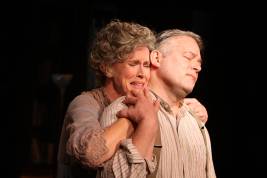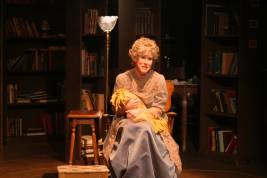
The word dysfunctional may not have been bandied about in the early 1910s when Eugene O’Neill’s Long Day’s Journey Into Night takes place, nor in the early ‘40s when it was completed, nor even in the middle of the Eisenhower ‘50s when it was published posthumously and made its Broadway debut. Still, if anyone understood dysfunctional families, or at least one dysfunctional family in particular, it was O’Neill, as Actors Co-op’s powerful 21st Century revival makes amply clear.
 Bruce Ladd is 65-year-old patriarch James Tyrone, stand-in for O’Neill’s own father James, an actor whose early promise failed to lead to lasting success in that most unstable of fields. It’s no wonder, therefore, that this product of a poor Irish immigrant family hoards every penny he’s earned, that is when he’s not reinvesting his savings in the purchase of new property, thereby leaving his family to live a nearly threadbare existence—and in near darkness after sunset, the better to save pennies on the electric bill. Like many an O’Neill protagonist—and both of his adult sons—James loves the drink, and you’ll probably see more whisky imbibed over the course of Long Day’s Journey’s three-and-a-half hours than in any play of even half its length.
Bruce Ladd is 65-year-old patriarch James Tyrone, stand-in for O’Neill’s own father James, an actor whose early promise failed to lead to lasting success in that most unstable of fields. It’s no wonder, therefore, that this product of a poor Irish immigrant family hoards every penny he’s earned, that is when he’s not reinvesting his savings in the purchase of new property, thereby leaving his family to live a nearly threadbare existence—and in near darkness after sunset, the better to save pennies on the electric bill. Like many an O’Neill protagonist—and both of his adult sons—James loves the drink, and you’ll probably see more whisky imbibed over the course of Long Day’s Journey’s three-and-a-half hours than in any play of even half its length.
Nan McNamara is Mary Tyrone, once fresh and untainted and full of hope and promise, now a slave to the morphine she started taking to ease the pain of her rheumatism-gnarled hands and continues to rely on to cushion her lonely life. Recently released from one of the many sanatoriums she’s been in and out of over the past few years, Mary finds her attempts at recovery no match for the pressures of living in a household of wrecks, and over the course of the single day in which the action of Long Day’s Journey takes place, we observe Mary’s descent into morphine-induced madness, as those around her watch on, powerless to help.
 David Scales is James Tyrone, Jr., aka Jamie, the couple’s older son, a thirty-three-year-old drunk whose entire life has been a series of failures and disappointments. Jamie spends much of his time deriding his father’s stinginess, that is when he’s not out drinking and whoring, and though he seems initially protective of his younger brother Edmund, we eventually learn that his relationship with his sibling is as twisted as they get.
David Scales is James Tyrone, Jr., aka Jamie, the couple’s older son, a thirty-three-year-old drunk whose entire life has been a series of failures and disappointments. Jamie spends much of his time deriding his father’s stinginess, that is when he’s not out drinking and whoring, and though he seems initially protective of his younger brother Edmund, we eventually learn that his relationship with his sibling is as twisted as they get.
Daniel J. Roberts is Edmund Tyrone, the twenty-three-year-old stand-in for the playwright himself, who like O’Neill spent several years as a sailor before returning to the family homestead, the victim of depression, alcoholism, and more recently of consumption (tuberculosis in contemporary terminology). It is only our knowledge of the successful career Eugene O’Neill pursued following his own extended sanatorium stay that gives us hope for what appears to be a future not all that much brighter than James’s, Mary’s, or Jamie’s.

 If this kind of family dysfunction continues to hold a fascination for audiences even in today’s let-it-all-hang-out world, imagine the reaction Broadway audiences must have had at a time when sitcoms like Leave It To Beaver, Ozzie And Harriet, and Father Knows Best ruled the airwaves. How must they have felt about emotions that could turn on a dime from love to hate to anger to blame and back again, all in a matter of minutes? How must they have felt about the unvarnished depiction of a “good woman” turned drug addict and a “good son” turned whoremonger? How must they have felt about a father who only thought he knew best and a son consumed with the desire to destroy the very brother he loved?
If this kind of family dysfunction continues to hold a fascination for audiences even in today’s let-it-all-hang-out world, imagine the reaction Broadway audiences must have had at a time when sitcoms like Leave It To Beaver, Ozzie And Harriet, and Father Knows Best ruled the airwaves. How must they have felt about emotions that could turn on a dime from love to hate to anger to blame and back again, all in a matter of minutes? How must they have felt about the unvarnished depiction of a “good woman” turned drug addict and a “good son” turned whoremonger? How must they have felt about a father who only thought he knew best and a son consumed with the desire to destroy the very brother he loved?
That being said, I must admit to being less in adulation of the O’Neill oeuvre than I am of Arthur Miller’s, Tennessee Williams’, or Edward Albee’s, to name three other 20th Century greats. I could do with a less melodramatic approach than O’Neill’s, not so much gloom and doom, and a much shorter running time. (At the risk of being accused of sacrilege, do we really need to spend three and a half hours with the Tyrones to figure out what makes these four people tick?)
Still, I can hardly find fault with Marianne Savell’s incisive, nuanced direction at the Co-op, or the powerful work being done by a cast entirely made up of company members, or the production’s superb design elements.
Ladd does some of his best work ever as James, his outward bluster hiding the self-doubts of a man whose failures in life have left him angry and disappointed, both in himself and in the family members who surround him. The superb McNamara is heartbreakingly real in an arc which takes her from the edginess of an addict on the verge of morphine withdrawal to the wide/empty-eyed gaze signaling yet another fall into the morphine-induced trance of her own long day’s journey into darkness. As Jamie, Scales undertakes by far his greatest challenge at the Co-op, one which he nails in a performance which captures not only the older sibling’s cynicism and sneer but also his insecurities and his heart. Daniels proves himself here, as he has in Co-op productions as diverse as The Philadelphia Story, The Crucible, and Makin’ Hay, to be one of the finest, most versatile (and watchable) young actors in town, revealing Edmund’s hopes, fears, anger, resentments, and love, as much in unspoken moments as in spoken ones. Completing the cast is the delightful Selah Victor, whose brief moments as sassy servant girl Cathleen offer a bit of sunlight amidst the gloom around her.
For this production, the Co-op’s blackbox theater has been reconfigured as a thrust stage, allowing for both the intimacy of theater-in-the-round and the more elaborate kind of set usually reserved for a proscenium stage. Still, I would have preferred not to have the intrusion of audience members in my sightlines when watching a play as intimate as Long Day’s Journey.
Scenic designer Gary Lee Reed’s terrific set fills the upstage wall with bookcase pillars behind which we glimpse a dining room to one side and a sitting room to the other, while downstage we have the Tyrone living room with its somewhat threadbare furniture and rug. Additional design kudos go to Bonnie Bailey-Reed for the set’s many period properties, including books galore, table settings, knickknacks, and of course whiskey bottles, decanters, and glasses in abundance. Bill E. Kickbush’s fine lighting design takes its own journey from morning to night, and turns the end of each scene into a powerful, dramatic tableau. Savell’s sound design features well-chosen mood music, night sounds such as a much mentioned foghorn, and footsteps which do indeed seem to be coming from the Tyrone house’s second floor above us. Paula Higgins’ costumes are period perfect. Diane Martinous has created a wig which greatly aids in McNamara’s transformation from her own youthful radiance to Mary’s washed-out middle age.
Long Day’s Journey Into Night is produced by Tannis Hanson. Matthew Hohmann is stage manager.
With Long Day’s Journey Into Dark, Actor’s Co-op once again challenges its audiences with darker, edgier material, the better to reach out beyond its subscriber core to the contemporary Angelino theatergoing audience at large, all the while offering its company members greater acting challenges than in seasons past. Though I might have preferred a bit shorter journey into night, the rewards of this superb production far outweigh any nits this reviewer might choose to pick.
Actors Co-op, 1760 N. Gower St., Hollywood.
www.actorsco-op.org
–Steven Stanley
March 31, 2012
Photos: Lindsay Schnebly


 Since 2007, Steven Stanley's StageSceneLA.com has spotlighted the best in Southern California theater via reviews, interviews, and its annual StageSceneLA Scenies.
Since 2007, Steven Stanley's StageSceneLA.com has spotlighted the best in Southern California theater via reviews, interviews, and its annual StageSceneLA Scenies.







 COPYRIGHT 2025 STEVEN STANLEY :: DESIGN BY
COPYRIGHT 2025 STEVEN STANLEY :: DESIGN BY